Overview
- Researchers report that Paralvinella hessleri accumulates arsenic in skin-cell granules where it reacts with hydrogen sulfide from hydrothermal vents to form orpiment, a less bioavailable mineral.
- Microscopy, spectroscopy and Raman analyses identify the bright yellow granules as orpiment (As2S3), explaining the worm’s striking coloration.
- Proteomic data indicate membrane-bound vacuoles contain putative arsenic transporters and hemoglobins that likely deliver sulfide, supporting a model of intracellular biomineralization.
- Arsenic can comprise more than one percent of the worm’s body weight, an adaptation documented in specimens from western Pacific vents including the Mariana Back-Arc toward the Okinawa Trough.
- The authors note similar arsenic hyperaccumulation in related worms and some Pacific snails, suggesting a possible shared strategy that remains unconfirmed due to limits on culturing and functional assays.
